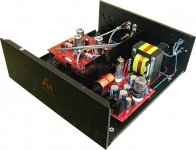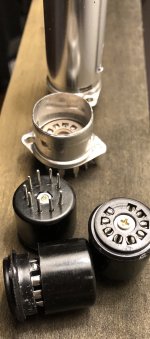I am building a phono stage and would like the tubes to protrude through the top of the chassis. Using socket savers is one way to get a little height. They are cheaply made which is a downside and seem like they would introduce vibrations and associated noise.
Any suggestions for a non-conductive silicone type substance to fill the socket saver with?
I would to include shields to cover the base up to where the tubes exit the chassis. A socket saver does not play very well with the two types of shielded bases I have but is nothing that can't be modified.
I could start by taking a DMM and seeing what I can read across a bead of dried silicone caulking but wondering if anyone has any suggestions. Yes, a company already hand produces such a product - just wanted to DIY it.
-Cheers

Any suggestions for a non-conductive silicone type substance to fill the socket saver with?
I would to include shields to cover the base up to where the tubes exit the chassis. A socket saver does not play very well with the two types of shielded bases I have but is nothing that can't be modified.
I could start by taking a DMM and seeing what I can read across a bead of dried silicone caulking but wondering if anyone has any suggestions. Yes, a company already hand produces such a product - just wanted to DIY it.
-Cheers
Attachments
The are non acid cure silicones available at standard hardware stores.
Be sure to choose fungicide free, clear or white is good.
Dan.
Be sure to choose fungicide free, clear or white is good.
Dan.
I am building a phono stage and would like the tubes to protrude through the top of the chassis.
Usually you would mount the tube sockets on the top of the board, and the large components
on the bottom, so the tubes could easily protude out of the top of the chassis as much
as you want, even as far as the top of the sockets.
Last edited:
Mounting on the chassis with the shields is the way to go.
Don’t try and reinvent the wheel. It will become a mess with adapters etc.
Likely the same wiring distance as with short wires from chassis mounted sockets to the pcb. Make sure the ones to V1 are shortest.
(Sounds like this is on a pcb)
Elastomer material like EAR sheets ( see Steve Bench’s old pages) in between chassis and socket eyelets is wise for a phono stage.
Don’t try and reinvent the wheel. It will become a mess with adapters etc.
Likely the same wiring distance as with short wires from chassis mounted sockets to the pcb. Make sure the ones to V1 are shortest.
(Sounds like this is on a pcb)
Elastomer material like EAR sheets ( see Steve Bench’s old pages) in between chassis and socket eyelets is wise for a phono stage.
I once fired-up a tube amp with nearly-cured RTV Silicone, and it caught fire.
As said, the stuff that smells like vinegar is good for bathtubs and bad-bad-bad for electric circuits.
As said, the stuff that smells like vinegar is good for bathtubs and bad-bad-bad for electric circuits.
Avoid self-curing silicones and those which cure by condensation, as both release small molecules during polymerization, such as formic or acetic acid or ethylic alcohol.
Best regards!
Best regards!
this is the product that was used to seal the chimneys on a installation of 2 gas fireplaces in my home. The product was used by the installers, not by me.
Hi-temperature Silicone Sealant (red) | Imperial Group
Hi-temperature Silicone Sealant (red) | Imperial Group
The word "fire" has me not wanting to try, but if I can find a spec sheet indicating it is safe to 400VDC, and not cause corrosion, maybe. This is a first for wishing I had any piece of audio equipment gold plated.
Top of chassis will be either 10mm or 19mm thick (because I have remnants, and it would match the shelf).
I'll try the Belton shielded base sockets with a red silicone x-rings under them. One thing I'm wondering about the shields, do they need to be brought to ground to make them functional as a shield? I was going to use a shield, but cut the top off.
The socket saver in the shielded base socket is a tight fit. Removing it on a populated PCB may not be possible. But... the shield height is the same as the socket saver which is an improvement.
Yes, at this point trying to mount sockets to the PCB.
If I'm successful in drilling the holes for the top of the chassis, pictures to follow.
Top of chassis will be either 10mm or 19mm thick (because I have remnants, and it would match the shelf).
I'll try the Belton shielded base sockets with a red silicone x-rings under them. One thing I'm wondering about the shields, do they need to be brought to ground to make them functional as a shield? I was going to use a shield, but cut the top off.
The socket saver in the shielded base socket is a tight fit. Removing it on a populated PCB may not be possible. But... the shield height is the same as the socket saver which is an improvement.
Yes, at this point trying to mount sockets to the PCB.
If I'm successful in drilling the holes for the top of the chassis, pictures to follow.
First take a cured sample of your silicone and see what happens if you put a cigarette lighter to it. Some burn very nicely as the silicone is an oxidiser.
This stuff (Dow Corning RTV 3145) has been used in commercial avionics (by some very large companies) for decades.
DOW CORNING RTV-3145 ADHESIVE / SEALANT from Aircraft Spruce
It is a neutral cure silicone suitable for electronics (non-corrosive). It has a dielectric strength of approx. 485V/mil. I have never seen it tested for flammability but I do know that it can tolerate a great deal of heat (200°C/392°F). If it comes into contact with an actual flame for a prolonged period of time it might burn (I have never tested it) but if it is contained in a socket its opportunity for that kind of exposure is pretty limited.
Good luck whatever solution you decide.
Matt
DOW CORNING RTV-3145 ADHESIVE / SEALANT from Aircraft Spruce
It is a neutral cure silicone suitable for electronics (non-corrosive). It has a dielectric strength of approx. 485V/mil. I have never seen it tested for flammability but I do know that it can tolerate a great deal of heat (200°C/392°F). If it comes into contact with an actual flame for a prolonged period of time it might burn (I have never tested it) but if it is contained in a socket its opportunity for that kind of exposure is pretty limited.
Good luck whatever solution you decide.
Matt
filling a "socket saver" with dampening material? silicone?
Belton 9 Pin Miniature Chassis / PC Mount Socket
| TubeDepot.com
This are designed for pcb AND chassis mount.
There must be a provision on the pcb for the connection.
They’re used in the audio note L3 phono stages as well; except not using the chassis mount configuration.

It’s so the tube shield is grounded regardless of chassis connection.
It’s not entirely clear to me how one mounts these on both the chassis and the pcb.
It’s the Belton VT9-PT-C
I’ve started a new topic on them in the parts section as it’s OT.
See here: Belton VT9-PT-C
Belton 9 Pin Miniature Chassis / PC Mount Socket
| TubeDepot.com
This are designed for pcb AND chassis mount.
There must be a provision on the pcb for the connection.
They’re used in the audio note L3 phono stages as well; except not using the chassis mount configuration.

It’s so the tube shield is grounded regardless of chassis connection.
It’s not entirely clear to me how one mounts these on both the chassis and the pcb.
It’s the Belton VT9-PT-C
I’ve started a new topic on them in the parts section as it’s OT.
See here: Belton VT9-PT-C
Last edited:
I used silicone to isolate the open connections on EDCOR's cheap OPTs. Hahaha, the fuse kept blowing untill a couple of days... Wet silicone conducts just fine, once fully cured it isolates. Not sure the type of silicone, just regular black type for building work, probably gassed me good while it cured...
I've just ordered some of this: H48-6-150-150-5.0-1A t-Global Technology | Fans, Thermal Management | DigiKey
Hope to use some left overs as tube dampers. Cut out a round piece, make a hole, and slide it down the preamp tubes. No idea if it's any good. Will try and report back what I find out.
Hope to use some left overs as tube dampers. Cut out a round piece, make a hole, and slide it down the preamp tubes. No idea if it's any good. Will try and report back what I find out.
- Status
- Not open for further replies.
- Home
- Source & Line
- Analogue Source
- filling a "socket saver" with dampening material? silicone?
